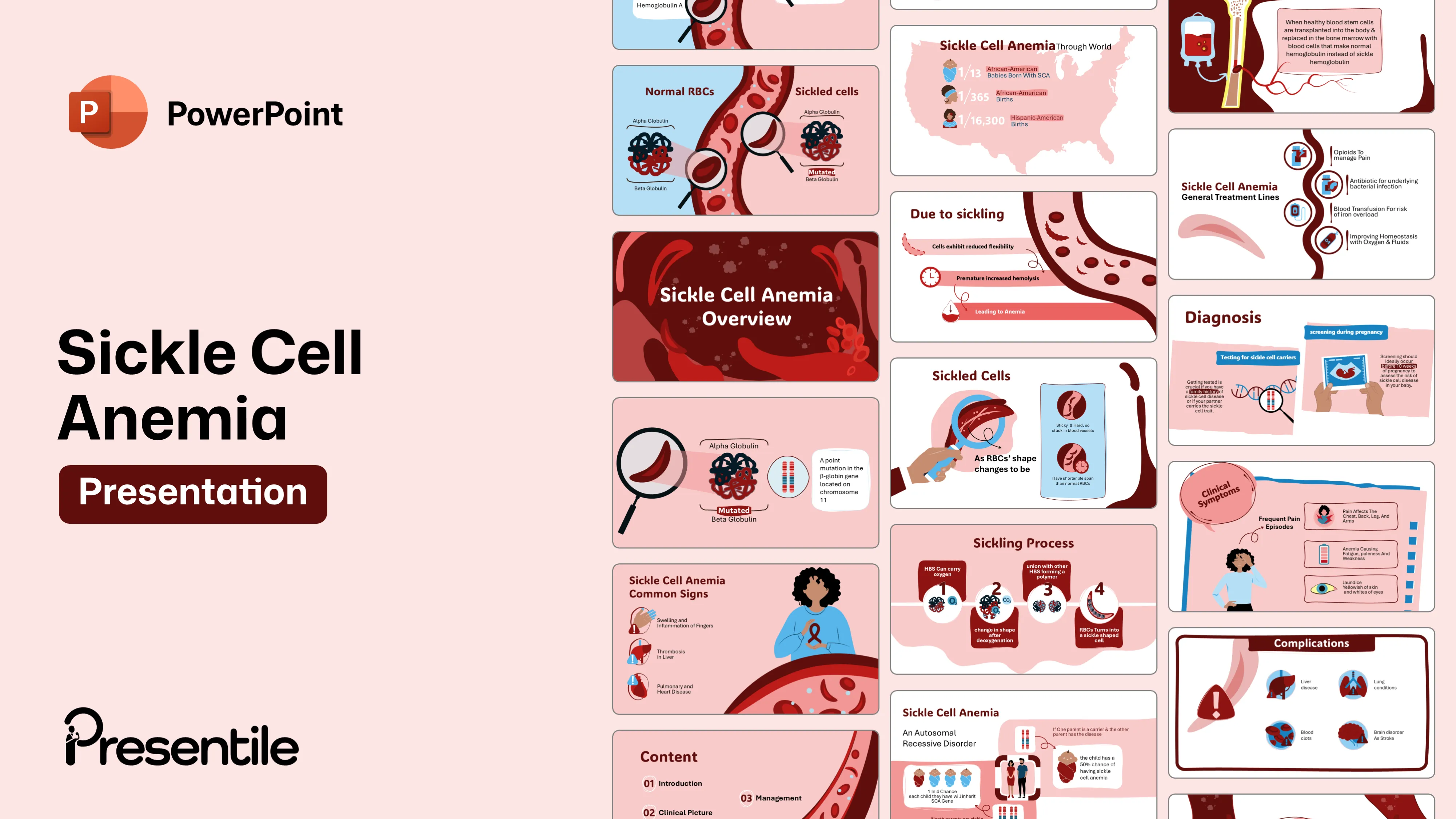
Content of
Sickle Cell Anemia Presentation
Slide 1: Sickle Cell Anemia Overview
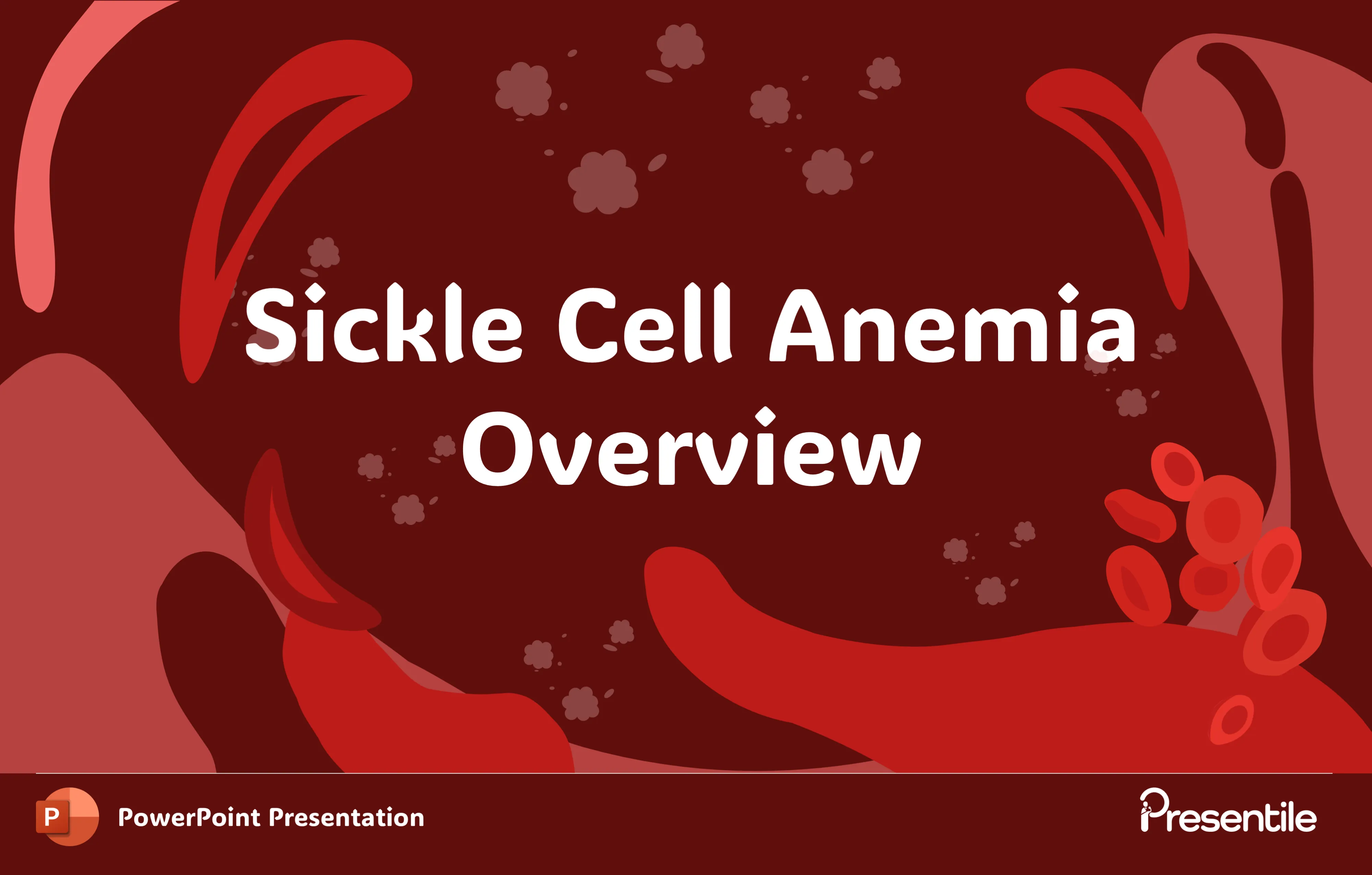
- This title slide provides an immediate visual and thematic introduction to the presentation on Sickle Cell Anemia.
- The rich red tones and abstract shapes evoke a sense of blood and pathology, while key illustrations of both normal and sickle-shaped red blood cells are subtly incorporated into the design.
- The title, “Sickle Cell Anemia Overview,” is prominently displayed in the center, setting a clear and professional tone for a comprehensive medical topic.
- This design is both informative and visually engaging, attracting attention from the very start.
Slide 2: Sickle Cell Anemia – Presentation Content

- This slide serves as the content and agenda for the presentation. It outlines three main sections: Introduction, Clinical Picture, and Management.
- The list is clear and easy to follow, providing the audience with a roadmap of the discussion.
- The background visual of a blood vessel containing both healthy, round red blood cells and misshapen, sickle-shaped cells is a powerful and relevant graphic that visually foreshadows the topics to be covered.
Slide 3: Sickle Cell Anemia – Common Signs

- This slide provides a clear and organized overview of common signs and symptoms of Sickle Cell Anemia.
- It uses three distinct icons to represent key clinical manifestations: swelling and inflammation of fingers, thrombosis in the liver, and pulmonary and heart disease.
- The visual hierarchy, along with a human figure holding a red ribbon, effectively connects these symptoms to a person’s experience, making the information relatable.
- This slide serves as a powerful visual guide for understanding the systemic impact of the disease.
Slide 4: Normal vs. Sickled Red Blood Cells
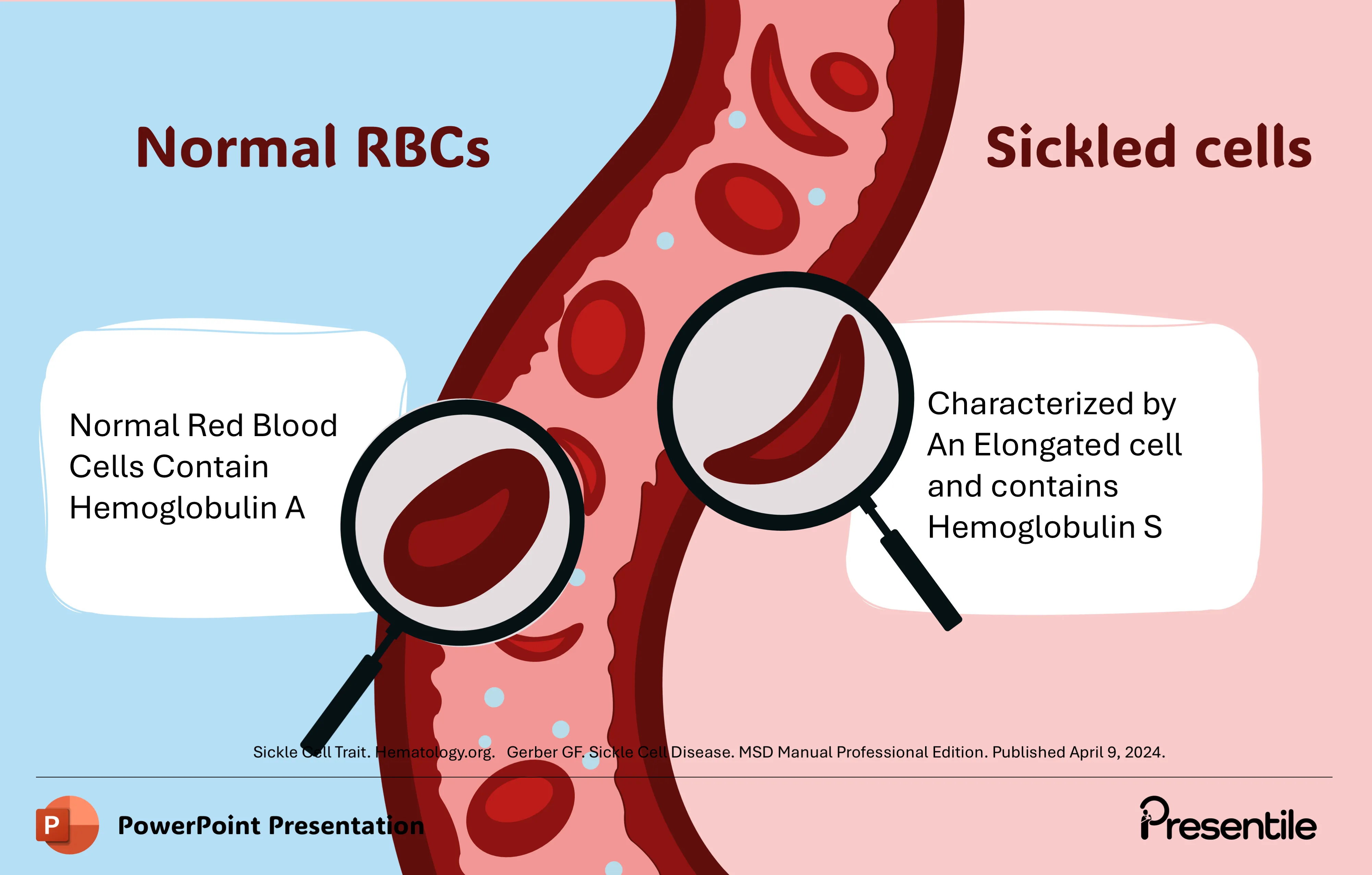
- This slide visually contrasts normal red blood cells (RBCs) with sickled cells, providing a foundational understanding of the disease’s pathology.
- On the left, it shows healthy, round RBCs containing Hemoglobin A.
- On the right, it illustrates the misshapen, elongated sickled cells that contain Hemoglobin S.
- The two magnifying glasses draw attention to these key differences, making the microscopic distinction easy for the audience to see and understand.
- This visual comparison is essential for explaining the core biological defect in sickle cell anemia.
Slide 5: Genetic Basis of Sickle Cell Anemia

- This slide delves into the genetic cause of Sickle Cell Anemia, focusing on the molecular difference between normal and sickled cells.
- It illustrates the structure of hemoglobin, showing that normal red blood cells contain a Beta Globulin chain.
- In contrast, sickled cells have a mutated Beta Globulin chain.
- The magnifying glasses highlight this key difference at the molecular level, effectively explaining the underlying genetic mutation that causes the red blood cells to deform.
Slide 6: Point Mutation on Chromosome 11
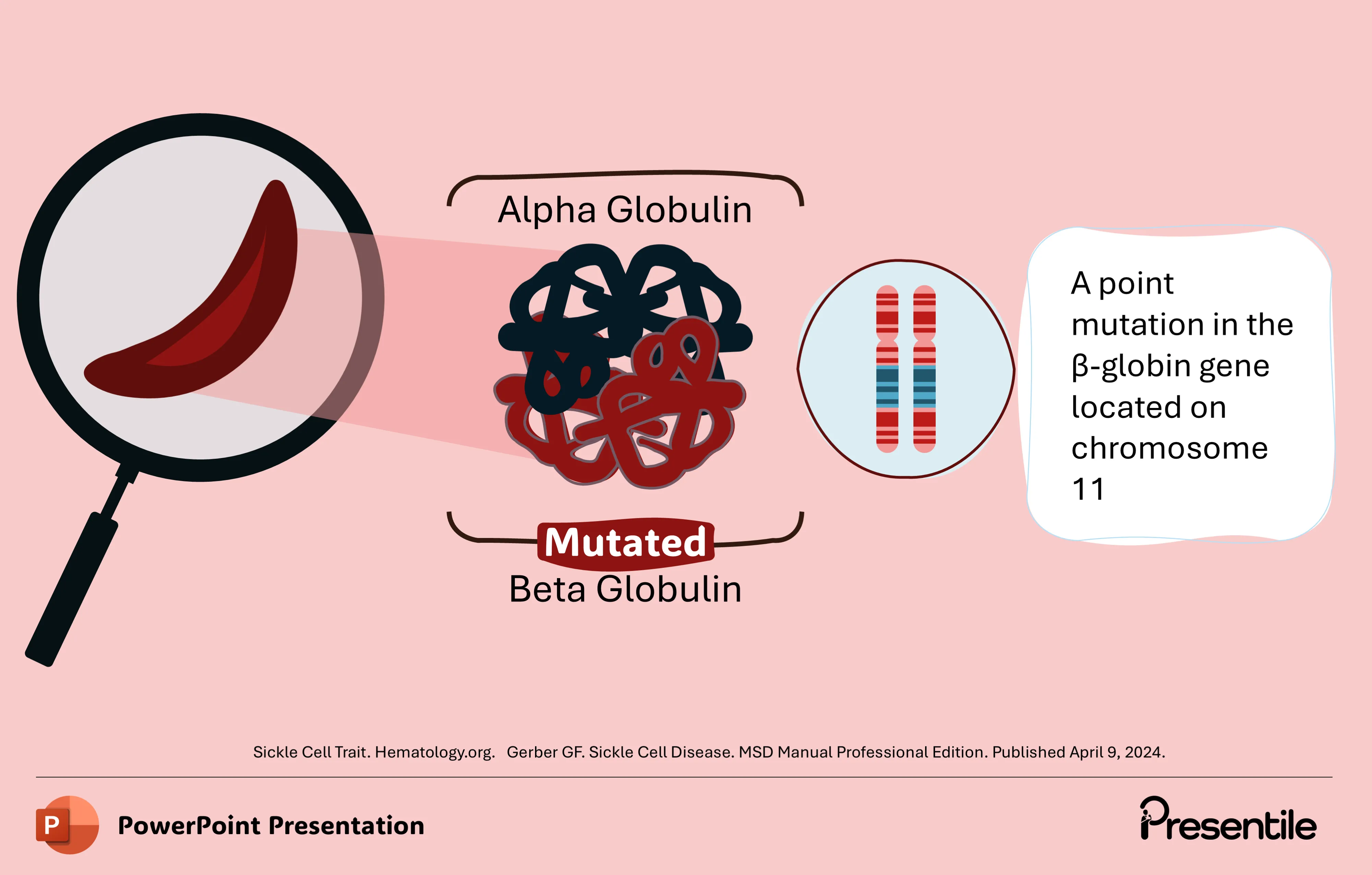
- This slide provides a more detailed explanation of the genetic cause of sickle cell anemia.
- It specifically identifies the underlying issue as a point mutation in the β-globin gene, which is located on chromosome 11.
- The visual effectively connects the abstract concept of a point mutation to its physical location on the chromosome and its resulting impact on the beta-globin chain.
- This detailed breakdown provides a deeper, more technical understanding of the disease’s origin.
Slide 7: The Sickling Process – A Four-Step Breakdown

- This slide visually explains the sickling process in a clear, four-step sequence.
- It begins by showing how Hemoglobin S (HBS) can initially carry oxygen.
- The next step illustrates a change in shape after deoxygenation, followed by the third step where deoxygenated HBS molecules unite with other HBS molecules to form a polymer.
- The final step shows the result of this polymerization, as the red blood cell turns into a sickle-shaped cell, obstructing blood flow.
- This flow chart-like presentation effectively simplifies a complex pathological process.
Slide 8: Consequences of Sickled Cells
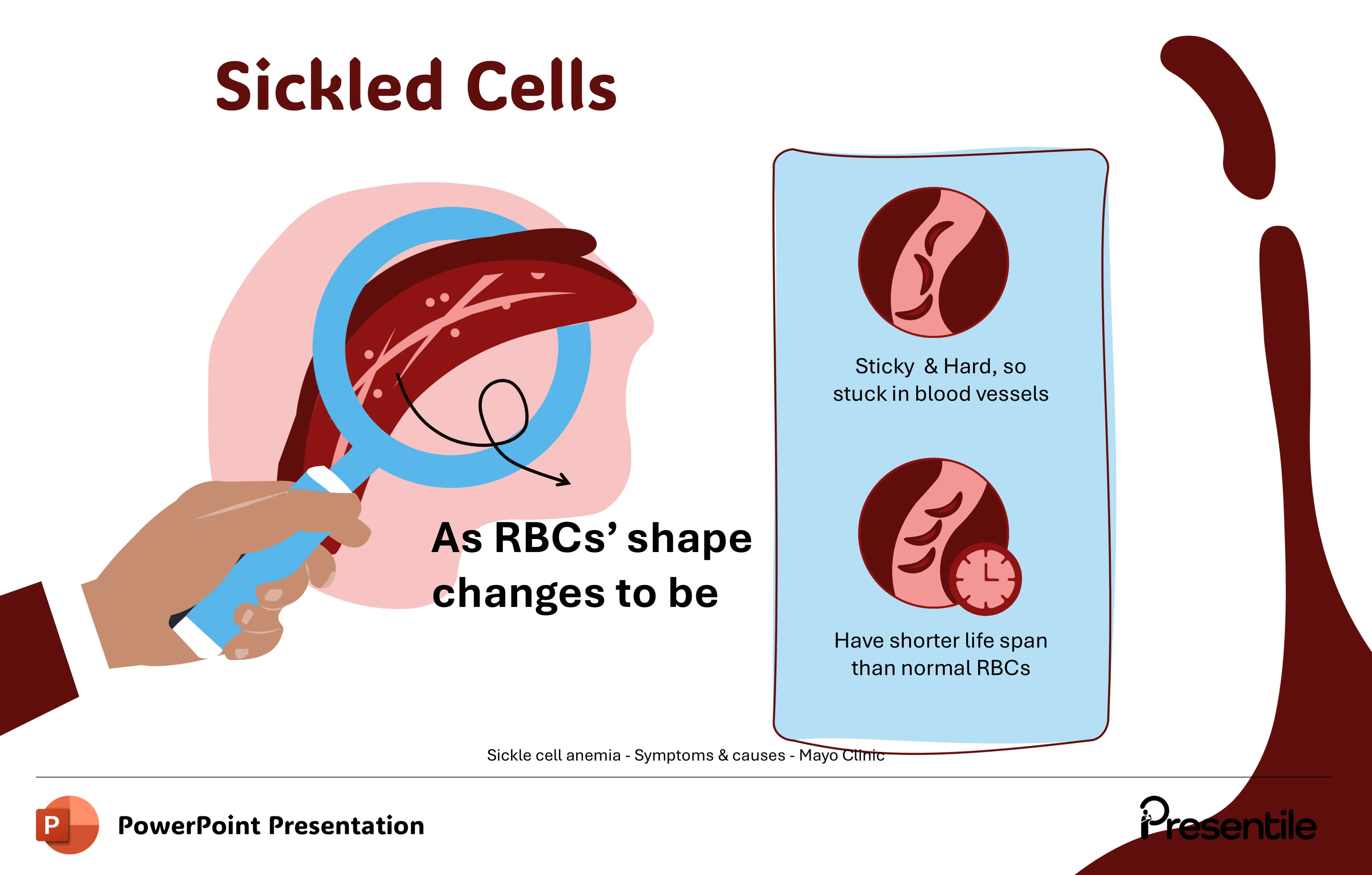
- This slide highlights the two major consequences of a red blood cell changing into a sickled cell.
- First, the misshapen cells become both sticky and hard, causing them to get stuck in blood vessels, a key factor in sickle cell crises.
- Second, these sickled cells have a shorter lifespan than normal red blood cells, leading to chronic anemia.
- The visuals clearly show a magnified sickled cell and two smaller illustrations that symbolize these two consequences, providing a clear and easy-to-understand summary of the disease’s impact.
Slide 9: Consequences of Sickling

- This slide outlines the direct consequences of the sickling process.
- It breaks down the chain of events into three key points: first, the sickled cells exhibit reduced flexibility, making it difficult for them to pass through small blood vessels.
- This lack of flexibility leads to the second point, premature and increased hemolysis (the destruction of red blood cells), as the rigid cells break down easily.
- This increased destruction ultimately leads to the final outcome: anemia, due to the body’s inability to replace the destroyed cells quickly enough.
- This visual sequence clearly explains how the cellular defect leads to the major clinical symptom of the disease.
Slide 10: Sickle Cell Anemia – A Global Perspective
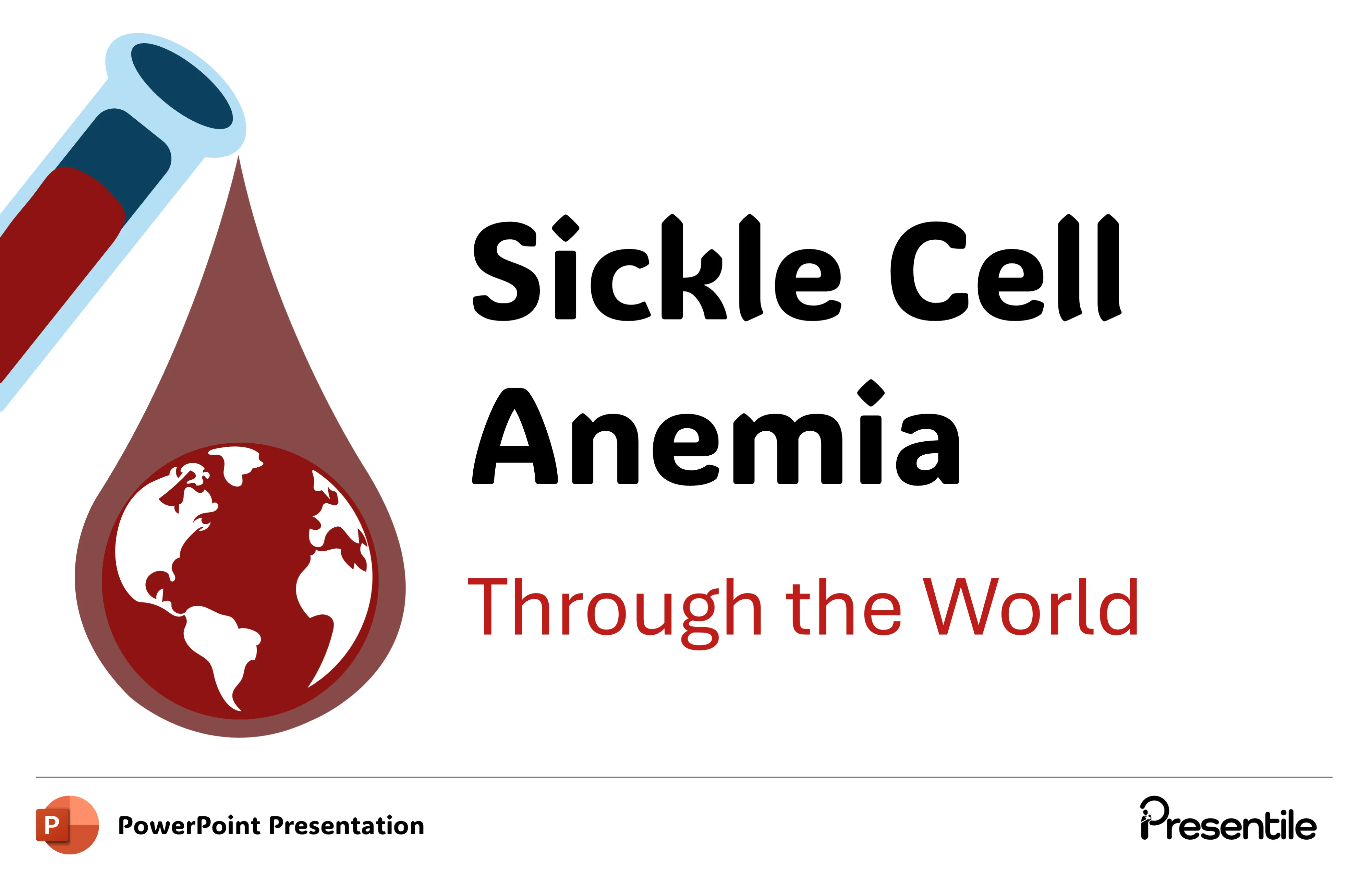
- This slide provides an introduction to the global scope of Sickle Cell Anemia.
- The visual features a large drop of blood, containing a map of the world, emerging from a test tube.
- The title “Sickle Cell Anemia Through the World” clearly states the focus on the disease’s global distribution.
- This powerful image serves to highlight that this condition is a worldwide health concern, setting the stage for a discussion on its prevalence and impact across different regions.
Slide 11: Sickle Cell Anemia – Prevalence in the U.S.
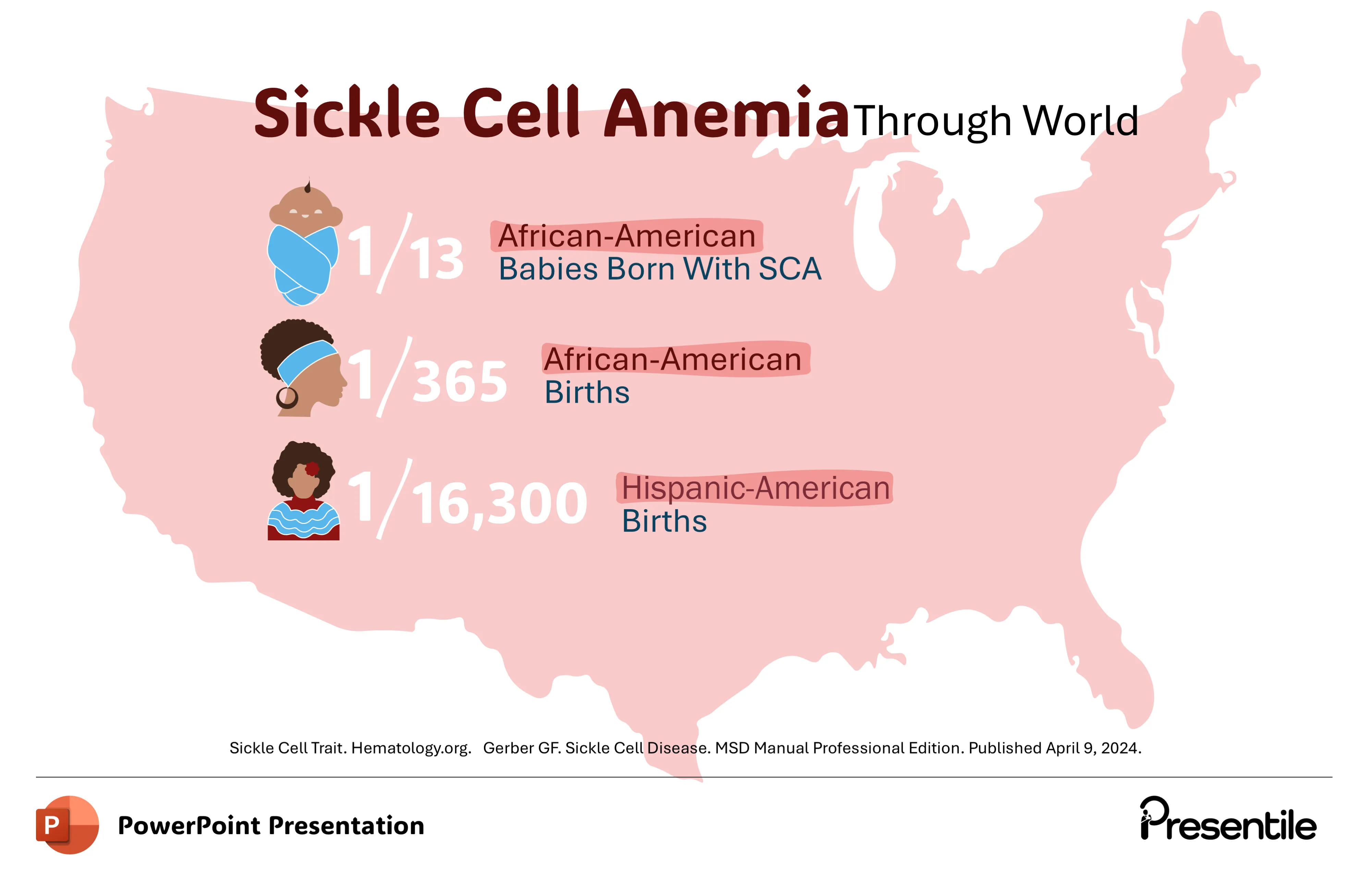
- This slide focuses on the prevalence of Sickle Cell Anemia (SCA) in the United States, using a map of the country as the background.
- It provides specific statistical data for different populations. Key statistics presented are: 1 in 13 African-American babies are born with the sickle cell trait (SCT), 1 in 365 African-American births result in SCA, and 1 in 16,300 Hispanic-American births result in SCA.
- This clear, data-driven slide effectively highlights the disproportionate impact of the disease on specific ethnic groups within the U.S., making the information both impactful and easy to comprehend.
Slide 12: Genetic Inheritance – Autosomal Recessive Disorder

- This slide explains that Sickle Cell Anemia is an autosomal recessive disorder, meaning a child must inherit two copies of the mutated gene to have the disease.
- It provides two key inheritance scenarios with clear visuals.
- The first scenario, in which both parents are sickle cell carriers, shows that each child has a 1 in 4 chance of inheriting the SCA gene.
- The second scenario illustrates that if one parent is a carrier and the other parent has the disease, there is a 50% chance the child will have sickle cell anemia.
- This slide effectively demystifies the genetics behind the disease, making the inheritance patterns easy to understand.
Slide 13: The Clinical Picture – Symptoms of Sickle Cell Anemia
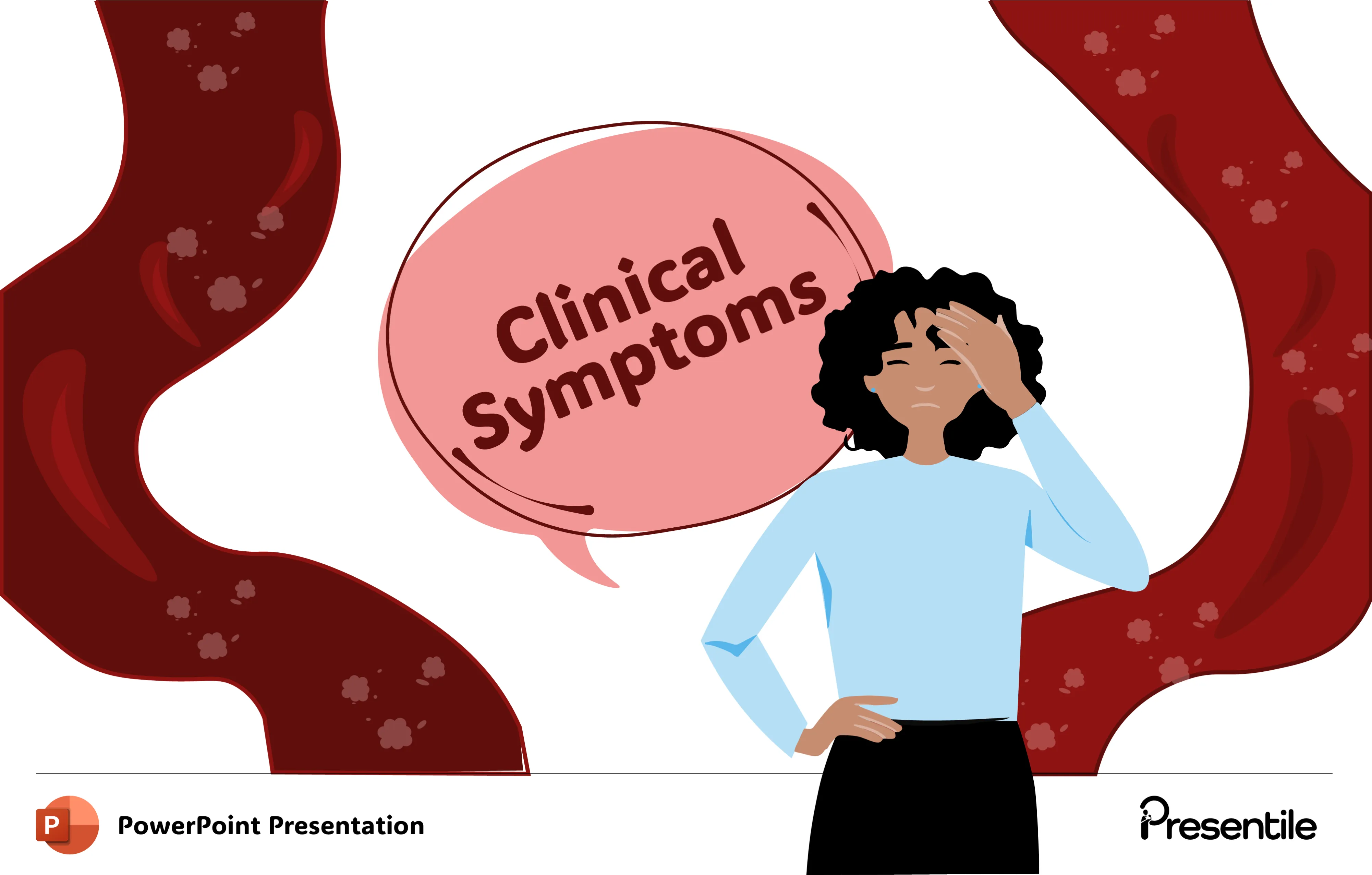
- This section slide introduces the Clinical Symptoms of Sickle Cell Anemia.
- The design features a figure holding her head, symbolizing the pain and distress associated with the condition.
- The text “Clinical Symptoms” is prominently placed in a thought bubble, visually representing the patient experience. The background shows blood vessels, connecting the human symptoms to the underlying disease pathology.
- This slide effectively sets the stage for a detailed discussion of how the disease presents in patients.
Slide 14: Frequent Pain Episodes and Other Symptoms

- This slide details the most common clinical symptoms of Sickle Cell Anemia, starting with frequent pain episodes.
- These painful events, known as crises, often affect the chest, back, legs, and arms.
- The slide also highlights other key symptoms: anemia, which leads to fatigue, paleness, and weakness, and jaundice, characterized by the yellowish color of the skin and whites of the eyes.
- The icons for pain, a low battery, and a jaundiced eye make these complex symptoms easy to recognize and understand.
Slide 15: Diagnosing Sickle Cell Anemia
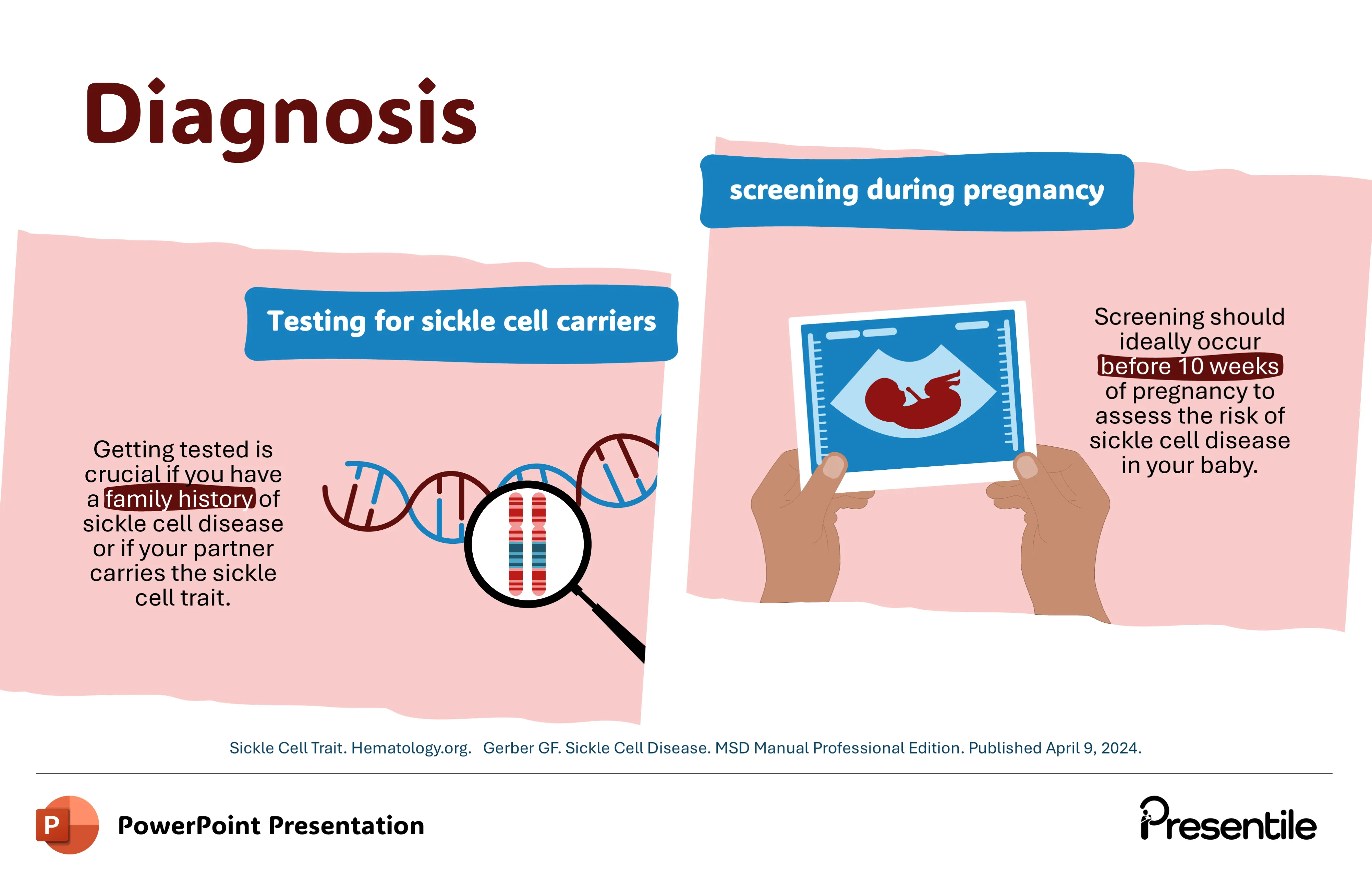
- This slide provides a two-part overview of the diagnostic process for Sickle Cell Anemia.
- On the left, it emphasizes the importance of testing for sickle cell carriers, particularly for those with a family history of the disease or if their partner is a carrier. The visual of DNA strands and a magnified chromosome highlights the genetic nature of the screening.
- On the right, the slide discusses screening during pregnancy. It advises that this should ideally occur before 10 weeks of pregnancy to assess the risk of the baby having sickle cell disease.
- The image of an ultrasound clearly represents this prenatal diagnostic step, effectively covering both pre-conception and prenatal screening methods.
Slide 16: Sickle Cell Anemia – Treatment Options

- This section slide introduces the various treatment options for Sickle Cell Anemia.
- The visual shows a person holding pills, while a thought bubble with the words “Treatment Options” is prominently displayed.
- The background contains a stylized depiction of red blood cells and medication, symbolizing the medical management of the disease.
- This slide sets the stage for a detailed discussion on the different therapies available to help patients manage their symptoms and improve their quality of life.
Slide 17: Sickle Cell Anemia – General Treatment Guidelines

- This slide provides an overview of the general treatment lines for Sickle Cell Anemia.
- The design uses a vertical flow chart to clearly present four key treatment areas.
- These include using opioids to manage pain, antibiotics for underlying bacterial infections, blood transfusions (with a note about the risk of iron overload), and improving homeostasis with oxygen and fluids.
- Each point is accompanied by a relevant icon, making the information easy to understand and remember.
- This slide serves as a comprehensive summary of the main medical interventions for managing the disease.
Slide 18: Hydroxyurea Treatment for Sickle Cell Anemia

- This slide provides a clear overview of the benefits of Hydroxyurea, a key medication used to treat sickle cell anemia.
- The visual of a pill bottle and capsules effectively introduces the topic of pharmacological management.
- The four bullet points, each with a corresponding icon, detail the positive outcomes of this treatment: it reduces the likelihood of pain events (acute chest syndrome), prevents symptoms like acute chest syndrome, reduces the need for blood transfusions, and reduces emergency visits and hospitalizations.
- This slide clearly communicates how this specific treatment improves patient health and quality of life.
Slide 19: The Healing Process – Bone Marrow Transplant
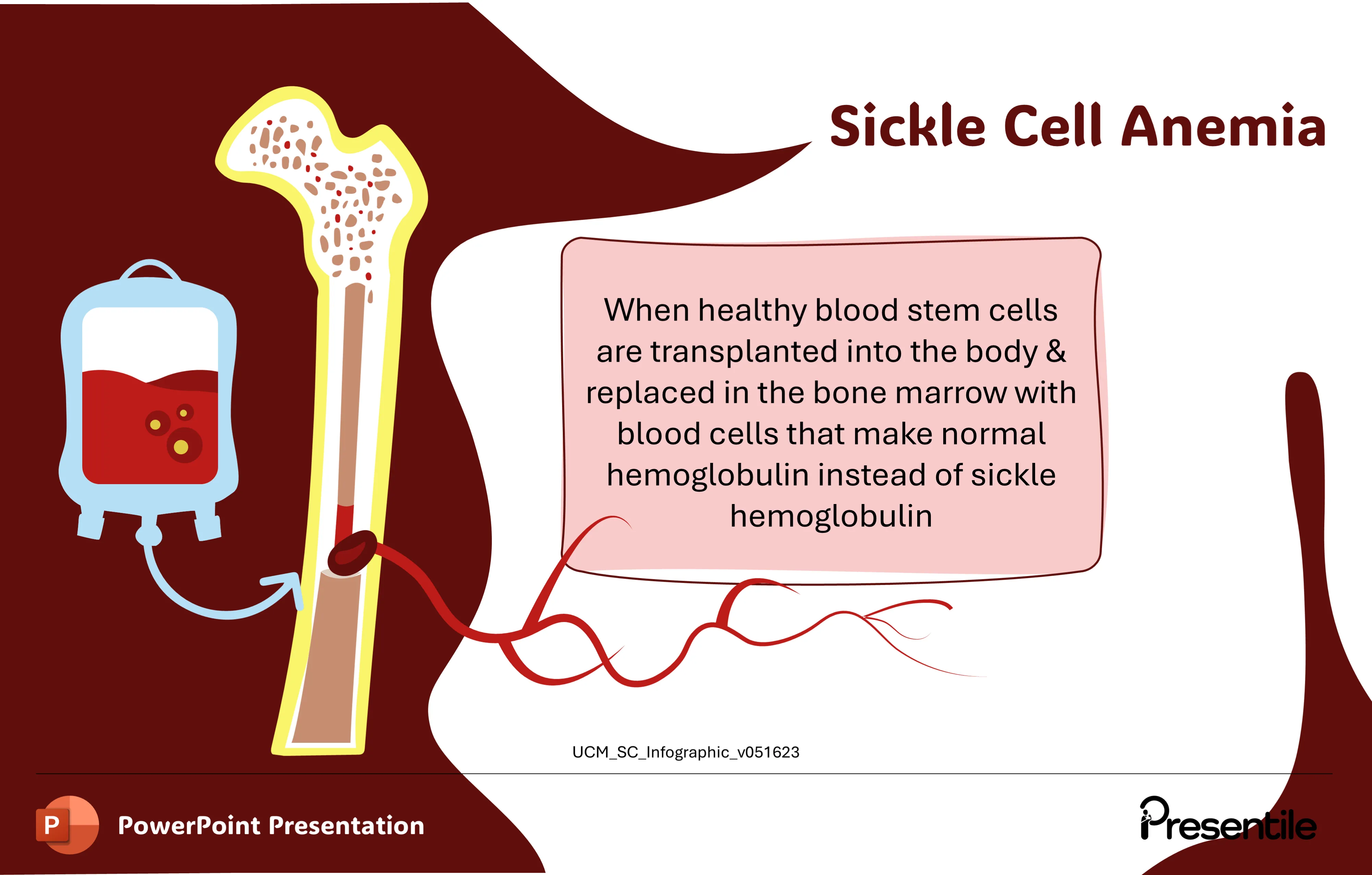
- This slide focuses on a definitive treatment for Sickle Cell Anemia: a bone marrow transplant.
- The text explains that this procedure involves transplanting healthy blood stem cells into the body.
- These new cells then replace the diseased cells in the bone marrow, allowing the body to produce normal hemoglobin instead of the sickle hemoglobin.
- The visual shows a healthy bone marrow, a blood bag, and an infusion line, clearly illustrating how new cells are introduced to the patient’s system.
- This slide effectively explains how a bone marrow transplant can cure the underlying genetic defect of the disease.
Slide 20: Common Complications of Sickle Cell Anemia
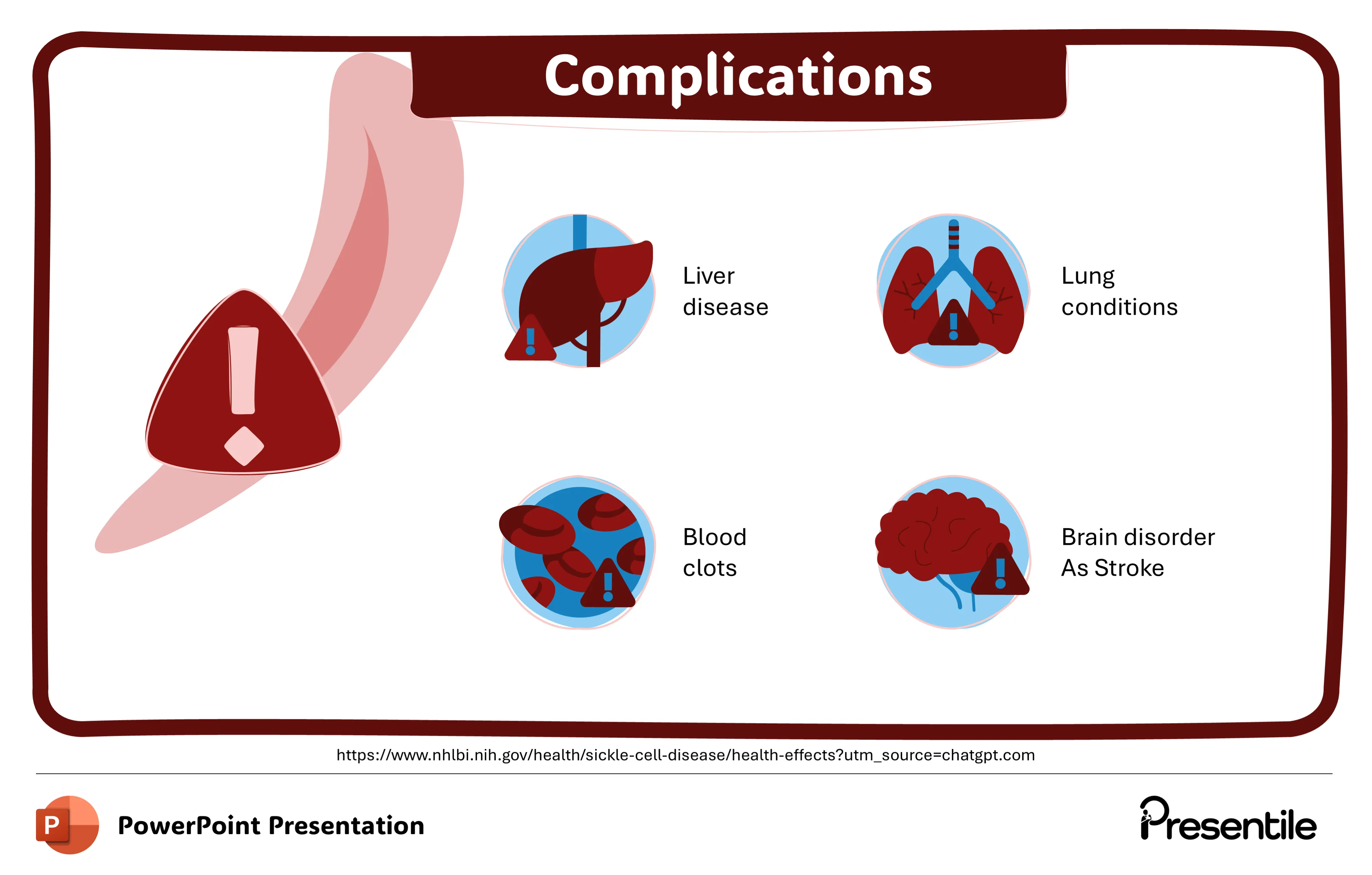
- This slide outlines the major complications associated with Sickle Cell Anemia.
- The design uses four distinct icons to represent different organ systems affected by the disease.
- The complications highlighted are liver disease, lung conditions, blood clots, and brain disorders such as stroke.
- This clear, visually organized summary effectively communicates the systemic nature of the disease and its potential for severe, multi-organ damage, reinforcing the importance of proper management and care.
Slide 21: Thank You for Your Attention

- This final slide concludes the presentation with a warm and professional “Thank You.” The visual features a smiling medical professional in a lab coat, gesturing toward the words in a thought bubble.
- A stylized drop of blood in the background subtly connects back to the presentation’s central theme of medicine and treatment.
- This slide is a friendly and effective way to wrap up the discussion and open the floor for questions.
Features of
Sickle Cell Anemia Presentation
- Fully editable in PowerPoint
- All graphics are in vector format
- Medically Referenced information and data
Specifications
 Slides count:
Slides count: Compatible with:Microsoft PowerPoint
Compatible with:Microsoft PowerPoint File type:PPTX
File type:PPTX Dimensions:16:9
Dimensions:16:9
Files Included
 Non-animated PowerPoint
Non-animated PowerPoint Animated PowerPoint File
Animated PowerPoint File Animated PowerPoint with Voice Over
Animated PowerPoint with Voice Over PDF Documents with presentation script
PDF Documents with presentation script
Elevate Your Work with Our Innovative Slides
Thank you! Your submission has been received!
Oops! Something went wrong while submitting the form.
No items found.










